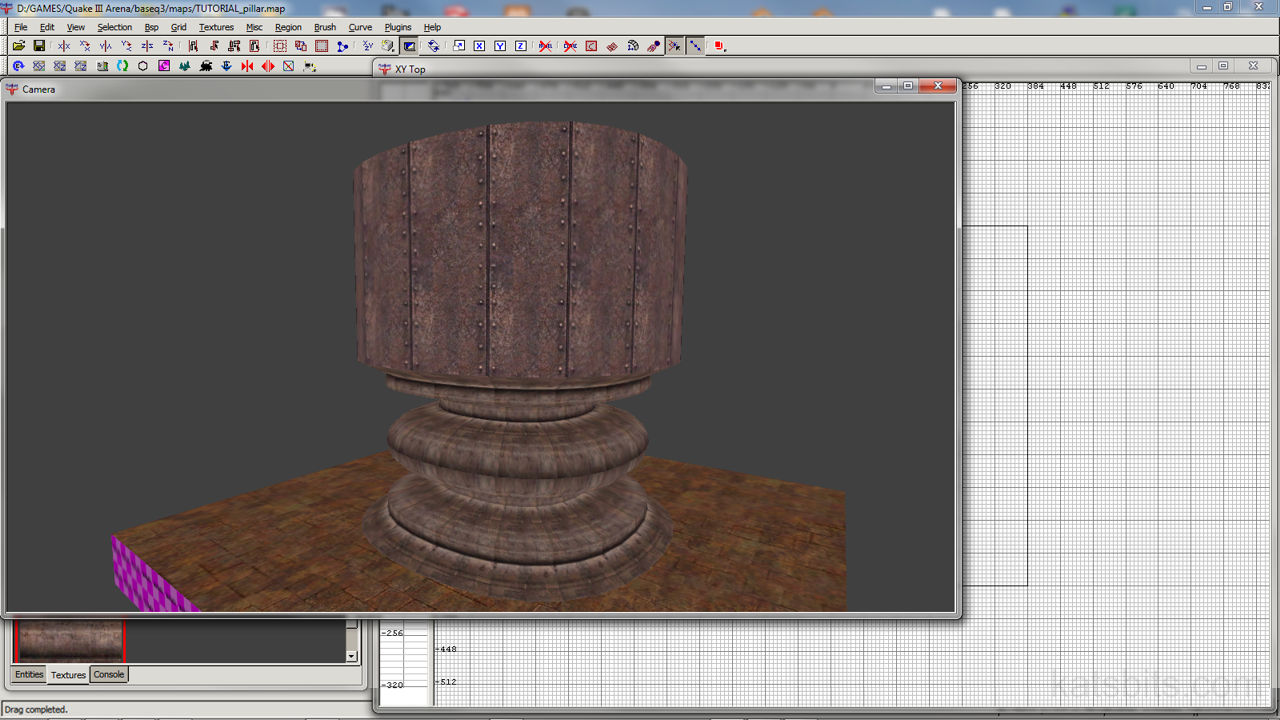Make A Column/Pillar From Patch Meshes In Radiant #2 – Multiple Meshes
Using multiple patches. Manipulating multiple patch meshes uses the same principles as outlined on the previous page, all we’re effectively doing is applying these techniques to more than one object.
Our starting point for this next section are the vertices on the bottom of the patch. Select the vertices (LMB+hold) along the bottom row and pull them out as shown above, changing views between front, side and top view so you can see the base taking shape.
Design note: remember, if you want to move or globally shape the patch mesh you have to exit vertex mode and go into normal editing mode ("V" exits with patch still selected, or "Esc" will exit and deselect the mesh)

Making a convex curve using multiple patch meshes
We now need to manipulate the middle set of vertices.

Manipulating the middle vertices to give a convex shaped mesh
If you select and pull out the middle set of vertices you’ll have something similar to the side view shown above (note the ‘new’ vertices are pulled out to fall directly above the base row) above, applying the same move to all the middle vertices will give us our convex mesh shape.
Editing Multiple Vertices & Duplication

Selecting multiple vertices
All we need to do now is flatten the curve a bit so it looks a little more convex and even. This time we need to select ALL the vertices on the top of the mesh. The best way to do this is to LMB+hold slightly away from the mesh and drag across the vertices we want to select. You should see a transparent blue shape being drawn in the editor windows showing you the active selection, similar to pictured above.
Design note: if you can’t see all the vertices clearly zoom into the mesh until you can. You can also select the vertices by holding the shift key down as you use the front, back and side views to click select each vertex.
Once you’ve selected and moved the vertices down, you should have something similar to the picture below; you can see how the curve is now a little bit smoother then before.

Flattening the mesh slightly
Again as before, you can change the shape by either manipulating the vertices or by doing it globally to the mesh itself in normal edit mode – if you do this though it flattens the whole mesh and not just a section of it – the vertices act as a ‘rotational point’, the point at which the mesh will rotate. Now we have our shape we need to duplicate/copy it.
Design note: you can ‘duplicate’ an exact copy of any brush or entity by press the space bar.
Exit vertex edit mode ("V" or "Esc") and select the mesh (if it isn’t already) copy it ("Ctrl+C") or "menu: edit » copy". Make sure you deselect it BEFORE you paste by pressing the "Esc" key, and then paste the copy, menu: edit » paste ("Ctrl+V"). It will appear in exactly the same place, the same way up and be highlighted as actively selected.
Rotating The Selection & More Shapes

Rotating the patch mesh selection
We need to rotate on of the patches by 180º. You can do this by pressing the x-axis Rotate button in the tool bar twice – it rotates 90º at a time – or from the menu command "menu: selection » rotate » rotate x" you should end up with something similar to the picture below.

The 2 ‘halves’ of our curve
All you need to do now is to move them close together creating our very smooth curved patch mesh as pictured below.

The two halves ‘joined’ together
You can as always edit the vertices to get a less rounded look to the patches.
[1: Patch Mesh Basics | 2: Multiple Meshes | 3: Advanced Patches | 4: Pillar Support]

